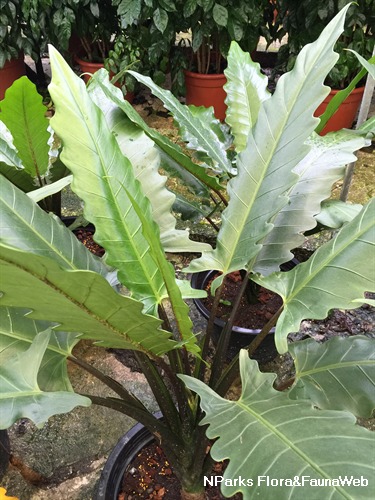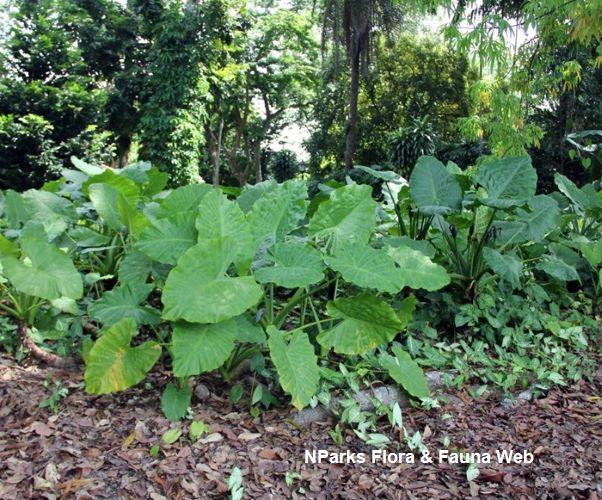
Back
Alocasia × mortfontanensis André
| Family Name: | Araceae |
| Synonyms: | Alocasia longiloba × alocasia sanderiana hybrid, Alocasia × amazonica (hort., nom. inval.) |
| Common Name: | African Mask, Amazon Elephant's Ear, 黑叶观音莲 |
Name
Classifications and Characteristics
| Plant Division | Angiosperms (Flowering Seed Plants) (Monocotyledon) |
|---|---|
| Plant Growth Form | Herbaceous Plant |
| Lifespan (in Singapore) | Perennial |
| Mode of Nutrition | Autotrophic |
| Plant Shape | Shrubby |
| Maximum Height | 0.6 m to 1.2 m |
| Maximum Plant Spread / Crown Width | 0.3 m to 0.5 m |
Biogeography
| Native Distribution | Horticultural (Amazon Nursery -- Florida, USA) |
|---|---|
| Preferred Climate Zone | Tropical |
Description and Ethnobotany
| Growth Form | Herbaceous aroid shrub, up to 1.2m height but often shorter, with pinkish-white underground rhizome. |
|---|---|
| Foliage | Large, smooth and thick, arrowhead-shaped, variably medium to dark green with prominent silvery to lime-white veins and undulating margins. Produced from basal rhizomes, and held like shields on stem-like petioles. |
| Flowers | Small, creamy-white, with separate male and female flowers distributed along finger-like spadix subtended by a light green spathe. Infrequently produced under local conditions. |
| Taxonomy | Traditionally known as Alocasia x amazonica, this plant name has been confirmed to be of horticultural origin, lacks a name authority, and was never validly published. In contrast to what the "amazonica" epithet suggests, the plant does not originate from the Amazon jungle or region. As Alocasia is strictly an Asian genus, no such plant are naturally distributed in the tropical Americas.The name appears to have originated in the 1950s from a now-defunct Florida nursery called "Amazon Nursery", whose owner (also sometime postman) Salvadore Mauro bred the plant from 2 parents (Alocasia longiloba and Alocasia sanderiana), and subsequently named it after his nursery. This artificial hybrid has been thought to share the same parents as Alocasia × mortfontanensis André -- scientifically published by botanist Éduard François André as "Alocasia mortfontanensis in Revue Horticole in 1891. This hybrid in turn was created by French gardener MM Chantrier in Mortefontaine, by crossing Alocasia lowii (now known to be a natural variation and hence synonym of Alocasia longiloba) with Alocasia sanderiana. According to some aroid growers, there is no apparent difference between Alocasia x amazonica and Alocasia × mortfontanensis, except that the latter sport larger leaves, although this could merely be a natural variation common amongst aroids.Since the end of 2009, Alocasia x amazonica is no longer recognized by taxonomic authorities as a valid botanical name. USDA GRIN Taxonomy, which previously indicated André as the name authority, has as of 16 Nov 09 relegated this plant name to horticultural status (Alocasia Alocasia x amazonica hort., nom. inval.). On the basis of the plant's supposed shared parentage, Kew Garden's "World Checklist of Selected Plant Families" has also subsumed it as a horticultural synonym of the currently-unplaced artificial hybrid name Alocasia × mortfontanensis André, 1891.On the other hand, aroid grower Steve Lucas believes that the shared parentage is errorneous, as based on an anecdotal account related by respected aroid grower John Banta, who visited Salvadore Mauro's nursery. According to Banta, Mauro informed that the actual parents were in fact Alocasia sanderiana x Alocasia watsoniana. Banta subsequently verified the claim by reproducing the exact same Alocasia x amazonica hybrid by using the parents that Mauro mentioned. Banta also informed that André did clarify in his 1891 Revue Horticole paper that the parents of Alocasia × mortfontanensis were wrongly ascribed to Alocasia x amazonica. Along these lines, it is assumed that the 2 hybrids do not share the same parentage, and are therefore totally different. The challenge thus appears to be for botanists and growers to attempt to recreate Alocasia x amazonica by trying out the 2 purported sets of parent species.However, Australian aroid botanist Alistair Hay had previously subsumed Alocasia watsoniana Sander (one of the supposed real parents in question) as a synonym of Alocasia longiloba Miq., on the basis that the former can be regarded as a variant within the Alocasia longiloba complex. As for Alocasia x amazonica itself, Hay (in correspondance with Lucas) thinks that the hybrid could possibly trace its history back to 19th-century European horticulture, before being recreated in Florida in the 1950s. Hay also holds the opinion that while the hybrid epithet is geographically misleading, the epithet origin being the name of Mauro's Florida nursery might be correct. As such, he supports the case for the International Aroid Society (IAS) or International Cultivar Registration Authority (ICRA) to publish Alocasia 'Amazonica' as a valid cultivar name to be used in place of Alocasia x amazonica.References:- USDA GRIN TaxonomyRoyal Kew Garden's World Checklist of Selected Plant FamiliesAlocasia Amazonica (Steve Lucas, 2009)Forum References:- University of British Columbia Botanical Garden & Centre for Plant Research: LINK1 University of British Columbia Botanical Garden & Centre for Plant Research: LINK2 International Aroid Society: LINK1 International Aroid Society: LINK2 |
| Cultivation | Provide bright filtered light -- plants placed long-term at overly-dim spots tend to decline and die. Soil should be constantly moist but quick-draining and well-aerated -- overwatered plants grown in soggy waterlogged soils are susceptible to bacterial stem and root rot. Suitable soilless media include peatmoss mixed with coarse perlite and orchid bark, with lots of organic matter. Foliage may die back due to plant entering dormancy, but new leaves will sprout in a few months if rhizome is kept moist. Propagate by division or rhizomes. Do not let pets chew on plant, as all parts contain irritant calcium oxylate crystals (as typically found in members of the Araceae family) - which produce a stinging and swelling effect on mucous membranes, and are toxic upon repeated ingestion. |
| Etymology | Genus epithet Alocasia derived from Greek terms 'a' (not) and 'kolokāsiā' (lotus root), alluding to its similarity to Colocasia, a closely-allied genus. Hybrid epithet mortfontanensis derived from the French commune Mortefontaine, where the hybrid was originally bred and described. |
Landscaping Features
| Desirable Plant Features | Ornamental Foliage |
|---|---|
| Landscape Uses | General, Flowerbed / Border, Container Planting, Indoor Plant |
| Usage Hazard - Cons | Irritant - Sap |
| Plant & Rootzone Preference or Tolerance Remarks | Likes moist but not waterlogged soils. Does not like overwatering. |
Plant Care and Propagation
| Light Preference | Semi-Shade |
|---|---|
| Water Preference | Moderate Water, Lots of Water |
| Plant Growth Rate | Moderate |
| Rootzone Tolerance | Fertile Loamy Soils, Well-Drained Soils |
| Maintenance Requirements | Moderate |
| Propagation Method | Storage Organ, Division |
Foliar
| Foliage Retention | Evergreen |
|---|---|
| Mature Foliage Colour(s) | Green, Silver / Grey, White |
| Mature Foliage Texture(s) | Smooth, Glossy / Shiny, Raised / Sunken Veins, Thick |
| Foliar Type | Simple / Unifoliate |
| Foliar Shape(s) | Non-Palm Foliage (Sagittate) |
| Foliar Venation | Pinnate / Net |
| Foliar Margin | Entire - Wavy / Undulate |
| Foliar Apex - Tip | Acuminate |
| Foliar Base | Auriculate |
| Typical Foliar Area | Mesophyll ( 45cm2 - 182.25 cm2 ) |
| Leaf Area Index (LAI) for Green Plot Ratio | 3.5 (Shrub & Groundcover - Monocot) |
Non - Foliar and Storage
| Stem Type & Modification | Acaulescent |
|---|---|
| Root Type | Underground (Fibrous Root) |
| Specialised Storage Organ(s) | Underground (Rhizome) |
Floral (Angiosperm)
| Flower & Plant Sexuality | Unisexual Flowers , Monoecious |
| Flower Colour(s) | Cream / Off-White, White |
|---|
| Inflorescence Type | Spathe & Spadix |
| Flowering Period | Rarely |
| Flowering Habit | Polycarpic |
Image Repository
Others
| Master ID | 346 |
|---|---|
| Species ID | 1642 |
| Flora Disclaimer | The information in this website has been compiled from reliable sources, such as reference works on medicinal plants. It is not a substitute for medical advice or treatment and NParks does not purport to provide any medical advice. Readers should always consult his/her physician before using or consuming a plant for medicinal purposes. |








